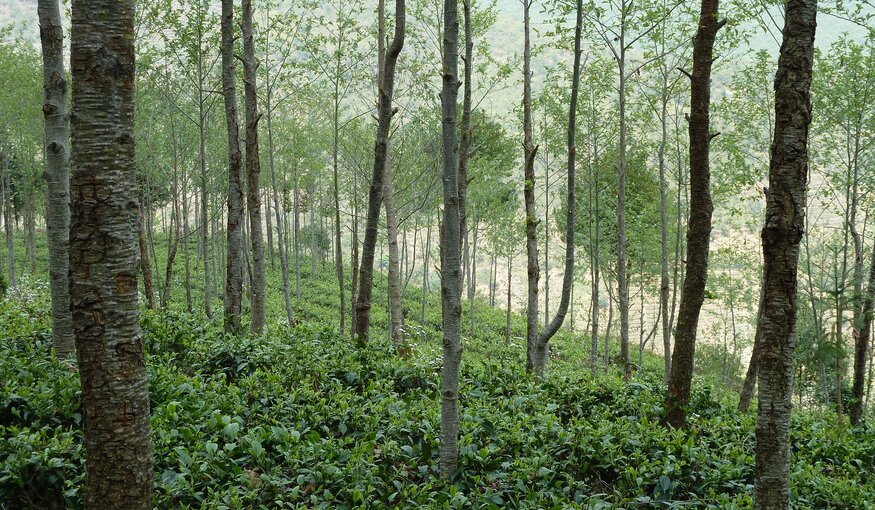‘Diversity Trees’ Shed Light on Gaps in Genebank Seed Collections
 Alder tea mixed agroforestry. Photo credit: ICRAF.
Alder tea mixed agroforestry. Photo credit: ICRAF.13 April 2022
The United Nations’ Sustainable Development Goal 2.5 calls on the world to maintain the genetic diversity of food. This includes cultivated plants, domesticated livestock and their related wild species.
The goal’s formal deadline of 2020 has passed, but we know there is more work to be done to safeguard and share genetic resources amid the growing challenges of climate change.
So, how do we measure our progress toward this elusive target?
One way is to use diversity trees as a benchmark to assess the current status of plant genetic resources collections, including the gaps within them and the overlaps between them.
Resembling a family tree, these are based on the different subgroups within a crop gene pool that are recognized by specialists in the crop. The subgroups represent important genetic differences within the crop, and the number of samples conserved in each can help identify future conservation needs.
The Crop Trust has developed 22 diversity trees based on consultations with some 60 experts and information from approximately 375 scientific papers. Each tree is published on the Genesys portal under the respective crop pages. The initiative was part of the Conservation Module of the CGIAR Genebank Platform.
Diversity trees were used to conduct a gap analysis of CGIAR genebank collections and are an important element of the Crop Trust’s Global Crop Conservation Strategies (funded by the German Federal Ministry of Food and Agriculture (BMEL)), which analyze existing genebank collections of crops at the global level. For each crop, the conservation strategy aims to answer the question: What diversity is still missing or underrepresented in the world’s genebanks?
Diversity trees are one of the key tools used to solve this puzzle.
“The aim is to identify subgroups that are both meaningful and as genetically different as possible,” says Theo van Hintum, head of plant genetic resources at the Center for Genetic Resources, Wageningen University and Research, in the Netherlands. “The tree helps to define a structure for the collection and opens up all kinds of possibilities for genebanks to better meet the diverse needs of their end users.”
In 2009, van Hintum was a co-author of the study that conceived the diversity tree. It proposed a strategy that relies on hierarchically structuring the crop gene pool and assigning a relative importance to each of its different components. By comparing the “optimal” distribution of the number of genebank samples in different ‘branches’ of the tree with their actual distribution, it is possible to identify under- and over-representation within a collection.
“We adapted the original idea from the paper as a tool for our specific task of conducting a gap analysis of CGIAR collections and to prioritize regions for further collecting,” says Peter Giovannini, Project Coordinator for the Crop Trust’s Global Crop Conservation Strategies. “For each group in the tree, we quantified the corresponding number of samples conserved in CGIAR collections and we identified gaps according to specific thresholds.”
“As a genebank manager, I want to know how the material we offer is being used,” van Hintum says. “For example, lettuce might be popular, but the cultivated seed samples are not requested much by our genebank’s users. It’s actually the wild material that is requested and used extensively—what we call the secondary gene pool. This is important information because it helps us aim our services to meet users’ needs. The diversity tree helps us meet shifting demand.”
Representation of genetic diversity changes with time, driven by the end user of the future, says van Hintum. For example, demand for wild species wasn’t so strong 30 years ago. But it has grown enormously in recent decades thanks to new breeding techniques, and can be expected to grow further with genomic tools that will make it easier to identify useful traits. This has led to an increased emphasis on collecting and conserving wild material.
The banana diversity tree is an example of gene pool mapping that led to action on the ground. It found that Fe’i bananas and other sub-groups from the Pacific Islands were underrepresented in the collection of the Bioversity International Musa Germplasm Transit Centre (ITC), the world’s largest banana genebank. Scientists conducted collecting expeditions to the Cook Islands and Samoa in 2019 to fill these gaps.
However, 31 percent of the 85 cultivated end-groups in the diversity tree are still not represented in the ITC collection, highlighting the ongoing challenge of collecting and conserving genetic diversity.
“We wanted to identify priority areas for collecting landraces, so we focused on the end-groups in the ‘branch’ of the diversity trees with landraces,” Giovannini says.
Diversity trees have also been developed beyond the work conducted for the Genebank Platform, according to Giovannini. Some of these have already been published, including those for the Cucumis (the group of plants which includes cucumber and cantaloupe) and Cucurbita (pumpkin and squash) crop gene pools, eggplants, and one for Trifolium (clovers). As part of the development of new global crop conservation strategies, experts are currently working on diversity trees for the gene pools of sunflower and Capsicum (peppers) crops.
“One legacy of the work conducted as part of the Genebank Platform is that both the method and the tools developed are now also being used to analyze the composition of genebank collections at the global level for the new conservation strategies” Giovannini says.
Category: Global Crop Conservation Strategies
